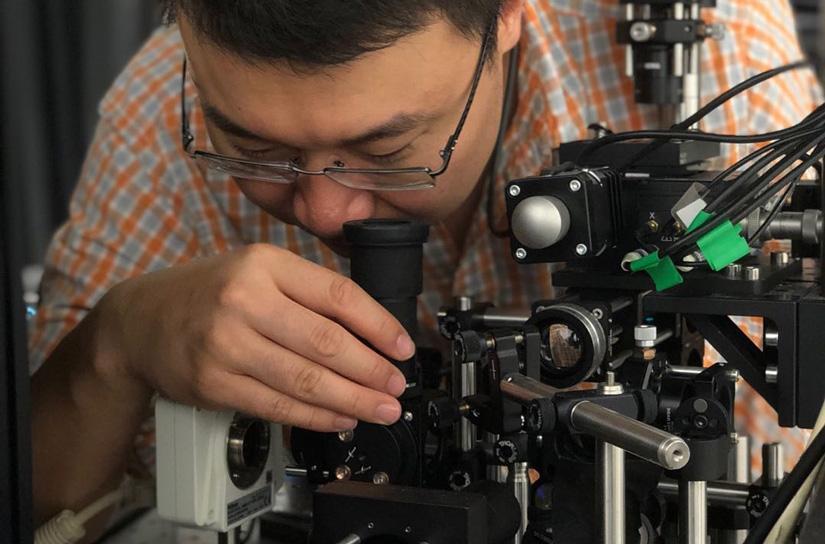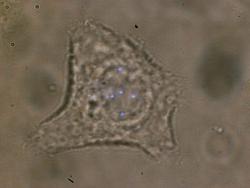Researchers from the UTS Institute for Biomedical Materials and Devices (IBMD) have developed a new microscopy technique, aimed at improving the resolution and sensitivity of nanoscale imaging. The discovery allows the human eye to track a single molecule and inspect its behaviour inside a living cell.

Dr Fan Wang’s pioneering bio-photonics research means the human eye can track a single molecule and inspect its behaviour inside a living cell. Credit: Image supplied by IBMD.
The pioneering research, published in the Nature journal Light: Science & Applications, means problems with imaging resolution and sensitivity can be overcome using relatively inexpensive, standard microscopes
Using a new class of nanoparticle sensors - upconversion Super Dots - that convert low-energy near-infrared photons into high-energy visible emissions, scientists have defined how many single photons are needed for the human eye to track a colour-tagged single molecule inside a living cell. The answer is 4000 photons per 100 milliseconds under a simple microscope setup!
This advance offers new tools for studying what is happening inside the cellular compartments responsible for how our bodies function and respond to treatments for disease and infection.
“Subcellular research is the new frontier in biomedical science and nanoparticles are the new tools for super resolution imaging and drug delivery,” says lead author Dr Fan Wang, a senior research fellow at IBMD.
Now we are developing new tools to enable the inspection of the individual cells in real time. At that intracellular level you get a fundamental understanding about how cancer spreads or how a particular treatment might work.
“Medicine has progressed from looking at symptoms from the outside of a person, to assess their health conditions, to looking inside using endoscopes and scans. Now we are developing new tools to enable the inspection of the individual cells in real time. At that intracellular level you get a fundamental understanding about how cancer spreads or how a particular treatment might work,” Dr Wang says.

A new class of nanosensors means sub cellular research is now possible and will answer questions about how our bodies function and respond to treatments for disease and infection. Credit: Fan Wang
“Our new generation of Super Dots sensors are stable, non-toxic, background free and very uniform, making them ideal for bio-imaging,” Dr Wang says.
The research complements the volumetric imaging platform IBMD is developing to decode the traffic conditions and environment to build a 3D “street view” inside living cells.
IBMD Director Professor Dayong Jin likened the development to having a Google car with sensing capabilities to detect a traffic jam.
“This new imaging technique is capable of monitoring, or tracking, a single optical sensor with high temporal, spectral and spatial resolution through cellular compartments,” Prof Jin says.
“We can measure the viscosity of the intracellular environment which means we can feel the ‘strength’ of each intracellular component and how they talk to each other,” Prof Jin says.
Dr Wang adds the new technique provides a fifth dimension for our eyes to simultaneously discriminate between multiple sets of single nanoparticles sensors, and gives colour-blind observers the ability to use fluorescence microscopes.
Funding:
Australian Research Council, National Health and Medical Research Council
Publication details:
Microscopic inspection and tracking of single upconversion in living cells. Fan Wang, Shihui Wen, Hao He, Baoming Wang, Zhiguang Zhou, Olga Shimoni, Dayong Jin Light: Science & Applications (2018) doi: 10.1038/lsa.2018.7

